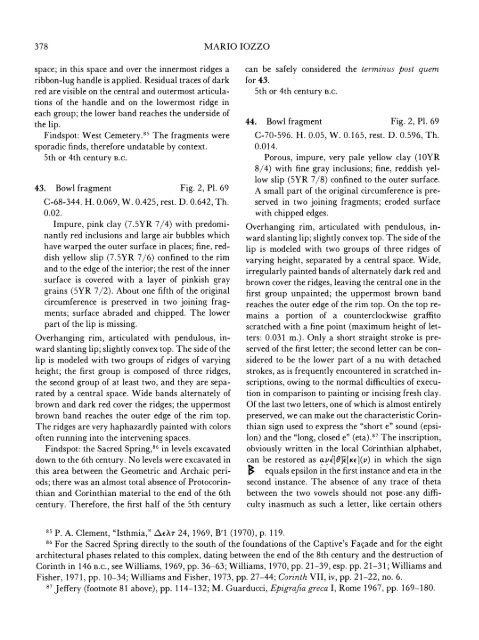f - The American School of Classical Studies at Athens
f - The American School of Classical Studies at Athens
f - The American School of Classical Studies at Athens
Create successful ePaper yourself
Turn your PDF publications into a flip-book with our unique Google optimized e-Paper software.
378 MARIO IOZZO<br />
space; in this space and over the innermost ridges a<br />
ribbon-lug handle is applied. Residual traces <strong>of</strong> dark<br />
red are visible on the central and outermost articula-<br />
tions <strong>of</strong> the handle and on the lowermost ridge in<br />
each group; the lower band reaches the underside <strong>of</strong><br />
the lip.<br />
Findspot: West Cemetery.85 <strong>The</strong> fragments were<br />
sporadic finds, therefore und<strong>at</strong>able by context.<br />
5th or 4th century B.C.<br />
43. Bowl fragment Fig. 2, P1. 69<br />
C-68-344. H. 0.069, W. 0.425, rest. D. 0.642, Th.<br />
0.02.<br />
Impure, pink clay (7.5YR 7/4) with predominantly<br />
red inclusions and large air bubbles which<br />
have warped the outer surface in places; fine, reddish<br />
yellow slip (7.5YR 7/6) confined to the rim<br />
and to the edge <strong>of</strong> the interior; the rest <strong>of</strong> the inner<br />
surface is covered with a layer <strong>of</strong> pinkish gray<br />
grains (5YR 7/2). About one fifth <strong>of</strong> the original<br />
circumference is preserved in two joining fragments;<br />
surface abraded and chipped. <strong>The</strong> lower<br />
part <strong>of</strong> the lip is missing.<br />
Overhanging rim, articul<strong>at</strong>ed with pendulous, inward<br />
slanting lip; slightly convex top. <strong>The</strong> side <strong>of</strong> the<br />
lip is modeled with two groups <strong>of</strong> ridges <strong>of</strong> varying<br />
height; the first group is composed <strong>of</strong> three ridges,<br />
the second group <strong>of</strong> <strong>at</strong> least two, and they are separ<strong>at</strong>ed<br />
by a central space. Wide bands altern<strong>at</strong>ely <strong>of</strong><br />
brown and dark red cover the ridges; the uppermost<br />
brown band reaches the outer edge <strong>of</strong> the rim top.<br />
<strong>The</strong> ridges are very haphazardly painted with colors<br />
<strong>of</strong>ten running into the intervening spaces.<br />
Findspot: the Sacred Spring,86 in levels excav<strong>at</strong>ed<br />
down to the 6th century. No levels were excav<strong>at</strong>ed in<br />
this area between the Geometric and Archaic periods;<br />
there was an almost total absence <strong>of</strong> Protocorinthian<br />
and Corinthian m<strong>at</strong>erial to the end <strong>of</strong> the 6th<br />
century. <strong>The</strong>refore, the first half <strong>of</strong> the 5th century<br />
can be safely considered the terminus post quem<br />
for 43.<br />
5th or 4th century B.C.<br />
44. Bowl fragment Fig. 2, P1. 69<br />
C-70-596. H. 0.05, W. 0.165, rest. D. 0.596, Th.<br />
0.014.<br />
Porous, impure, very pale yellow clay (1OYR<br />
8/4) with fine gray inclusions; fine, reddish yellow<br />
slip (5YR 7/8) confined to the outer surface.<br />
A small part <strong>of</strong> the original circumference is preserved<br />
in two joining fragments; eroded surface<br />
with chipped edges.<br />
Overhanging rim, articul<strong>at</strong>ed with pendulous, inward<br />
slanting lip; slightly convex top. <strong>The</strong> side <strong>of</strong> the<br />
lip is modeled with two groups <strong>of</strong> three ridges <strong>of</strong><br />
varying height, separ<strong>at</strong>ed by a central space. Wide,<br />
irregularly painted bands <strong>of</strong> altern<strong>at</strong>ely dark red and<br />
brown cover the ridges, leaving the central one in the<br />
first group unpainted; the uppermost brown band<br />
reaches the outer edge <strong>of</strong> the rim top. On the top remains<br />
a portion <strong>of</strong> a counterclockwise graffito<br />
scr<strong>at</strong>ched with a fine point (maximum height <strong>of</strong> letters:<br />
0.031 m.). Only a short straight stroke is preserved<br />
<strong>of</strong> the first letter; the second letter can be considered<br />
to be the lower part <strong>of</strong> a nu with detached<br />
strokes, as is frequently encountered in scr<strong>at</strong>ched inscriptions,<br />
owing to the normal difficulties <strong>of</strong> execution<br />
in comparison to painting or incising fresh clay.<br />
Of the last two letters, one <strong>of</strong> which is almost entirely<br />
preserved, we can make out the characteristic Corinthian<br />
sign used to express the "short e" sound (epsilon)<br />
and the "long, closed e" (eta).87 <strong>The</strong> inscription,<br />
obviously written in the local Corinthian alphabet,<br />
can be restored as av v[0][KE](v) in which the sign<br />
g equals epsilon in the first instance and eta in the<br />
second instance. <strong>The</strong> absence <strong>of</strong> any trace <strong>of</strong> theta<br />
between the two vowels should not pose.any difficulty<br />
inasmuch as such a letter, like certain others<br />
85 P. A. Clement, "Isthmia," ZX\7r 24, 1969, B'1 (1970), p. 119.<br />
86 For the Sacred Spring directly to the south <strong>of</strong> the found<strong>at</strong>ions <strong>of</strong> the Captive's Facade and for the eight<br />
architectural phases rel<strong>at</strong>ed to this complex, d<strong>at</strong>ing between the end <strong>of</strong> the 8th century and the destruction <strong>of</strong><br />
Corinth in 146 B.C., see Williams, 1969, pp. 36-63; Williams, 1970, pp. 21-39, esp. pp. 21-31; Williams and<br />
Fisher, 1971, pp. 10-34; Williams and Fisher, 1973, pp. 27-44; Corinth VII, iv, pp. 21-22, no. 6.<br />
87 Jeffery (footnote 81 above), pp. 114-132; M. Guarducci, Epigrafia greca I, Rome 1967, pp. 169-180.

















